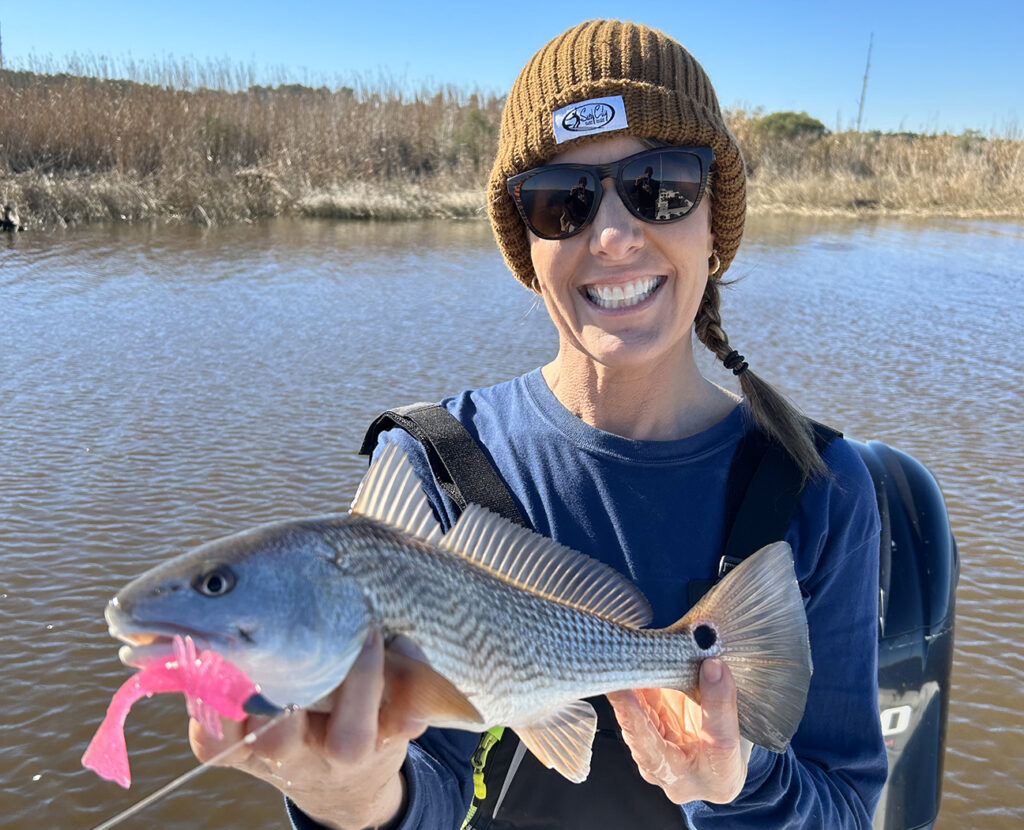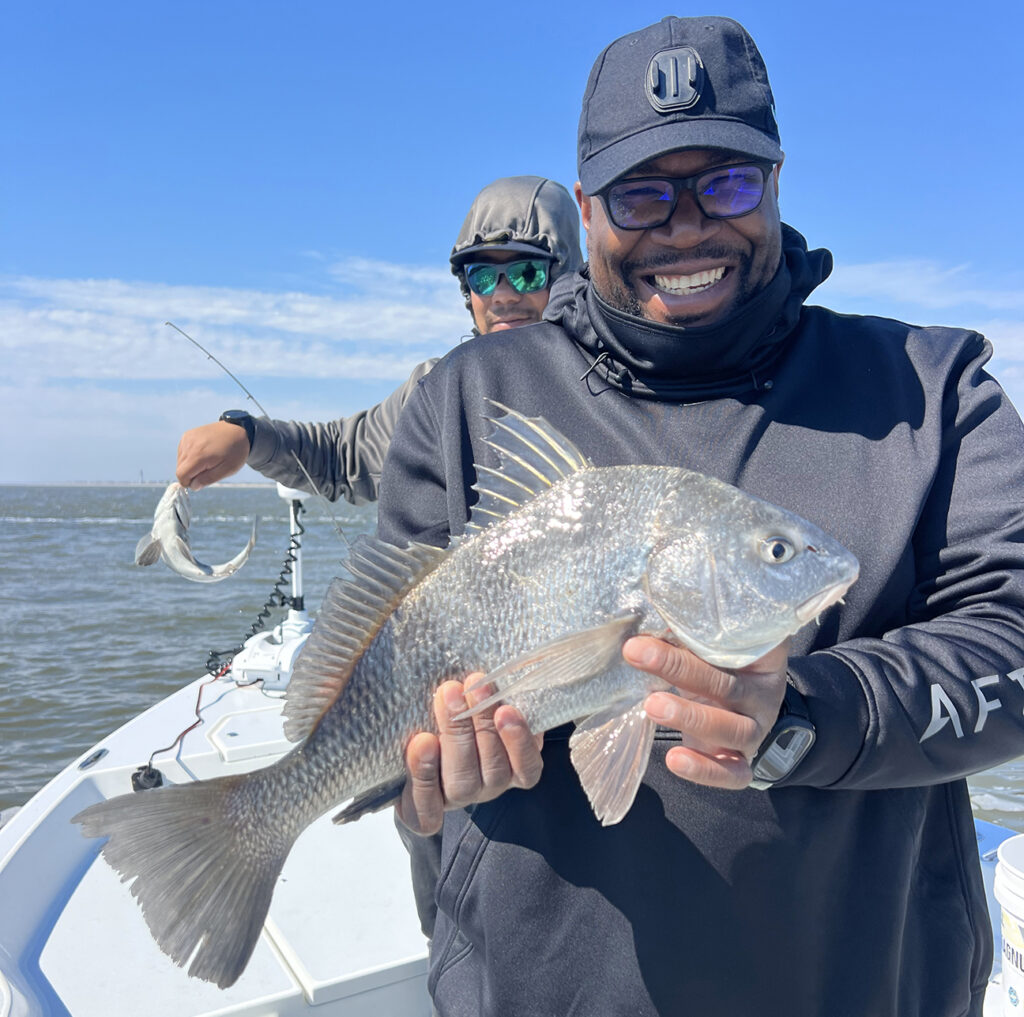Carolina Beach – April 2025
Lewis, of Island Tackle and Hardware, reports that surf fishing anglers have been hooking a variety of species that includes whiting, croakers, dogfish sharks, and skates.
Inshore anglers are catching some red drum and the occasional speckled trout. Some sheepshead are starting to move back inside, too, and they are setting up around structure.
Off the beach, black sea bass fishing in the 7-20 mile range has made up most of the action.
Christian, of Seahawk Inshore Fishing Charters, reports that anglers are catching red drum and black drum in the backs of creeks and in the shallower bays. The best tactic is to target areas with shell bottoms or oyster banks, and dead shrimp rigged either on the bottom or under a float has been getting most of the bites. The majority of the red drum are smaller (16-17” range), but some slots are mixed in.
As the water temperatures keep moving up, soft plastics such as Gulp shrimp or Z-Man scented soft plastics will start getting crushed as the redfish break out into smaller groups and scatter.
Anglers have seen some sea mullet in the deeper river channels. A two-hook bottom rig and fresh shrimp is best for them.
Luke, of Spot On Charters, reports that anglers are still seeing most of the inshore fish holding in the same winter patterns—in the backs of creeks off the Cape Fear River.
The red drum are getting a little more active, though, and are now striking artificial baits with a moderate retrieve speed.
Speckled trout are mixed in in the backs of these same creeks, but anglers have yet to see the larger, springtime spawning fish.

Elizabeth Caulder, of Wilmington, with this red drum caught in the Cape Fear River using a Goldleader custom 3.8″ shrimp. She was fishing with Capt. Stu Caulder of Goldleader Guide Service.
Tommy, of Mungo Fishing Charters, reports that black and red drum remain the most reliable targets as water temperatures continue to only slowly slide back up.
Anglers targeting red drum are doing best fishing the same patterns they did all winter. Natural baits such as dead shrimp or mud minnows rigged on Carolina rigs work best, and they should be fished around structure.
Artificials can now be successful in enticing a red drum bite, mostly when sight-casting to schools in shallow areas such as marsh bays or way back in creeks. With a good run of warmer conditions, these fish will break up and be found in more areas throughout the waterways.
For the black drum, it’s all about dead shrimp fished around hard structure, such as rock jetties, docks, and deep holes near oyster beds.
Mason, of Grand Slam Fishing Charters, reports that red drum are still hanging shallow, but they should be breaking up soon with the warming weather conditions. As the reds break out of their winter schools, they tend to feed a bit more aggressive. Anglers are still doing best by working structure and points in the creeks or around creek mouths, and dead shrimp is still the preferred bait choice (until live shrimp becomes more available).
Black drum fishing is picking up, with docks on higher tides as the prime target area.
The speckled trout bite should be picking up soon.
Drew, of Strike Inshore Charters, reports that red drum fishing has been consistent despite the fluctuations in air temps. The weather changes have the reds mostly sticking to their winter patterns, which is hanging in the backs of creeks off the lower Cape Fear River. The bites are coming on a variety of offerings, including Carolina-rigged dead shrimp or cut mullet, as well as soft plastics like Z-Man PaddlerZ and PrawnstarZ. Fishing anytime from the mid to low outgoing tide into the first hour after incoming has been the most effective.
Some scattered black drum are around these same oyster-structured areas, and they prefer bottom-rigged dead shrimp.
Tony, of Reel Teal Charters, reports that the red drum are still mostly in winter patterns, but they will soon start to push out of the creeks into larger waterways as more bait arrives. This movement has already been seen in the ICW around Carolina Beach, with more fish now holding around docks.
Black drum are mixed in around docks and other structure, and they’re feeding on dead shrimp.
Off the beach, bottom fishing remains the focus, with catches of black sea bass and other smaller bottom critters.

Lawrence, of Greensboro, caught this black drum in the lower Cape Fear River using cut shrimp. He was fishing with Capt. Christian Wolfe of Seahawk Inshore Fishing Charters.
Barry, of Family Ties Charters, reports that the offshore water temperatures have cooled down again, and this has slowed the action down for anglers looking to run out to the break. Those taking advantage of nice weather windows are picking away at blackfin tuna and scattered wahoo.
The jumbo black sea bass bite remains reliable anywhere in the 15-20+ mile range.
Closer to the beach, the Atlantic bonito will be some of the first to arrive. They begin to hold around structure, usually when water temperatures stay over 60 degrees.
Rod, of OnMyWay Guide Service, reports that out at the break, a bunch of dirty and cooler water (68 degrees) can be found all the way out to 1700’. This has the offshore bite slower, as anglers wait for some eddies spinning off that warmer water to bring the action in closer.
Some kings are being caught in the 30+ mile range.
Black sea bass fishing remains a bright spot, with some excellent action (in both sizes and numbers) in the 15-25 mile area.
A bunch of false albacore are out over structure in this same range.
Anglers are looking forward to gag grouper season opening up on May 1.
Nearshore anglers still await the arrival of Atlantic bonito. Many times, the fish first appear in areas to the north (off Wrightsville and Topsail).
